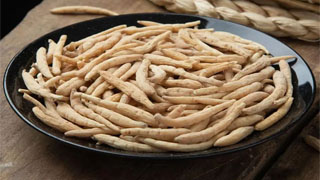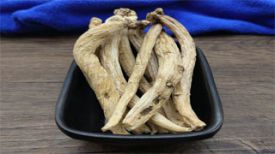
1. Aliases
Coal ginseng, Taibai ginseng, and black ginseng.2. Mineral morphology
Perennial herbaceous plant, 15-30 centimeters tall, with some reaching up to 50 centimeters tall. The root is thick and mostly emits 2-4 lateral roots from under the root neck, slightly spindle shaped, fleshy, with many fibrous roots. The rhizome is short, with a single stem or multiple stems emerging from the upper end of the rhizome. Leaves in the lower part of the stem are mostly pseudoopposite, while those in the upper part are alternate; The leaves are membranous, ovoid to lanceolate in shape, with fully lobed feathers and heavily serrated edges, with small spikes at the tips of the teeth. The raceme is terminal, 13-18 centimeters long, with short and slender pedicels densely covered with short hairs; Calyx membranous, oval tubular; The corolla is purple or red, 12-16 millimeters long, with a straight tube. The upright part of the helmet twists and turns twice on its own axis, and then strongly folds at the base containing the stamen part, making the beak point towards the back, curling into a semi circular shape. The end is 2-lobed, the lower lip is large, the middle lobe is small, and the width is obovate. The capsule is narrowly ovate to ovate lanceolate, with two compartments that are extremely unequal. The flowering period is from June to August, and the fruiting period is from August to September.
3. Origin distribution
Born on ditches, roadsides, and grasslands at an altitude of 1750-3500 meters. It is mostly distributed in Sichuan, Shaanxi, Gansu and other places.
4. Harvesting and processing
Harvest from August to October, remove impurities, and air dry.
5. Characteristics of medicinal herbs
The roots are conical or cylindrical in shape, with branched roots or multiple branches, measuring 10-20 centimeters in length and 1-2 centimeters in diameter. The surface is brownish to black, and the tip of the reed head is 1-2 centimeters long. The upper end of the main root has obvious and dense ring patterns, and the branch roots are easy to break off. The root marks are brownish brown. The texture is hard and brittle, easy to break, with a black brown skin on the cross-section and a yellow brown chrysanthemum heart on the wood, which is not fibrous. Slight breath, sweet taste, slightly bitter. Black color and hard and brittle texture are preferred.
6. Nature, taste, and meridian tropism
Warm in nature, sweet and slightly bitter in taste. Return to the Kidney Meridian and Spleen Meridian.
7. Effect and function
Nourishing Yin and Tonifying Kidney, Benefiting Qi and Strengthening Spleen. A tonifying yin medicine classified under the category of tonifying deficiency medicine.
8. Clinical applications
Internal administration: decoction, dosage 9-15g, high-dose 30-60g. Indicating spleen and kidney deficiency, bone steaming and hot flashes, joint pain, and lack of appetite.
9. Pharmacological research
Taibai ginseng has a significant inhibitory effect on the aging of mice induced by tetracycline; It has a significant inhibitory effect on liver injury in mice induced by tetracycline; It can significantly increase the energy reserve in the body of mice; It has anti free radical, anti-aging, anti liver damage effects, and promotes the body's motor function.
10. Chemical composition
This product contains alkaloids, phenols, organic acids, saponins, iridoid glycosides, phenylpropanoid glycosides, etc
11. Taboos for use
Anti quinoa. Avoid eating raw and cold foods, as well as soy sauce.
12. Compatibility prescription
① Treating dizziness due to body deficiency: 15 grams of Taibai ginseng and 15 grams of Codonopsis pilosula each, and 3 grams of Asarum. Boiled in water. (Handbook of Common Chinese Herbs in the North)
② Treatment for bone steaming, hot flashes, and joint pain throughout the body: 120-250 grams of Taibai ginseng, stewed pork or pig trotters, consumed in portions. (Shaanxi Chinese Herbal Medicine)
The content of the article is for clinical reference only. Non professionals in traditional Chinese medicine are not allowed to try medication.


